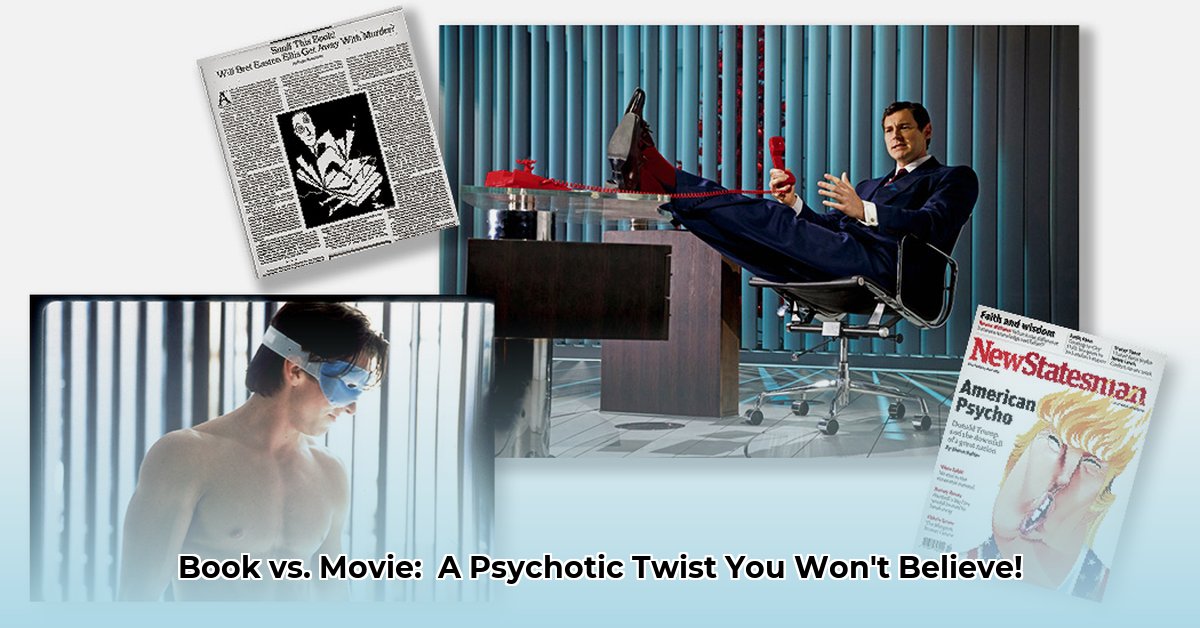
Let's delve into the captivating discrepancies between Mary Harron's 2000 film adaptation of American Psycho and Bret Easton Ellis's 1991 novel. Both narratives center on Patrick Bateman, a seemingly successful Wall Street executive concealing a disturbingly violent inner life, but their approaches diverge dramatically, offering vastly different experiences for audiences.
Shared Territory: Bateman's Superficial World
Both the book and the film effectively portray Patrick Bateman—the impeccably dressed, superficially charming yuppie masking a terrifyingly violent persona. The sharp suits, lavish dinners, and the iconic, exquisitely detailed business card all feature prominently in both versions. They successfully capture the 1980s Wall Street atmosphere, the dizzying consumerism, and the underlying anxieties surrounding masculinity and the pursuit of success. However, beyond these shared elements, the narratives diverge significantly.
Where the Stories Part Ways: A Sea of Differences
The differences between the book and film adaptation are striking. The novel's violence is relentlessly graphic, a brutal and unflinching exploration of Bateman's depravity that leaves little to the imagination. His murderous rampage involves numerous victims, depicted with explicit and disturbing detail. The film, in stark contrast, significantly diminishes the gore, portraying far fewer killings and considerably softening the brutality. This isn't simply an aesthetic choice; it fundamentally alters the story's impact on the audience. Filmmakers faced practical limitations—the challenges of depicting such intense violence realistically on screen, and navigating potential censorship hurdles. The cinematic medium necessarily necessitates restraint when it comes to explicit content compared to a novel's ability to explore such thematic areas without the same restrictions.
The contrasting writing styles also contribute significantly to the divergence. The book employs a stream-of-consciousness narrative, characterized by Bateman's rambling thoughts and detailed accounts of consumer goods (consider the extended passages on Paul Allen's music collection), all delivered in a detached, almost unreal tone which maintains a critical distance between the reader and the protagonist. The film, by necessity, streamlines this narrative, losing much of the novel's rambling and self-indulgent nature. This change significantly affects the pacing and, more importantly, the thematic resonance of the work.
Shifting Themes: Consumerism, Ambiguity, and the 80s Vibe
The novel uses Bateman's obsession with material possessions and pop culture references to highlight the emptiness and superficiality of his world, and the 1980s culture that shaped him. It's a potent social commentary. The film, however, introduces a significant layer of ambiguity. The audience is left questioning whether Bateman's violence is real or a product of his disturbed mind. The novel leaves far less room for such interpretation.
Several scenes omitted from the film—including the book's extensive use of homophobic slurs and a particularly unsettling scene involving a child—profoundly affect the interpretation of Bateman and the story's overall message. This raises a critical question: Did these cuts ultimately enhance or detract from the narrative's power? This remains a subject of ongoing debate among film critics.
Bateman's Transformation: A Different Kind of Monster?
Even the portrayal of Bateman himself is transformed in the adaptation. The book presents a more outwardly repulsive, almost cartoonishly evil Bateman. The film's version is more nuanced, arguably less overtly monstrous, yet still deeply disturbing. This shift is crucial; it alters how we engage with the character and interpret the story. The book's version, for some readers, may be almost unbearable, creating a sense of repulsion. The film's ambiguity, on the other hand, might frustrate others with its unresolved questions, fostering alternative interpretations.
Structure and Style: From Page to Screen
The film radically streamlines the novel's narrative. The book's lengthy, often meandering passages are condensed, necessitating choices about which plot points to retain and which to discard. The film utilizes a different set of tools—cinematography, music, and editing—contributing to a unique pacing and atmosphere. The film’s soundtrack, for instance, plays a significant role in shaping our understanding of the character and the overall tone. These stylistic choices differ fundamentally from the nuances available through the written word. Isn't it fascinating how different mediums can shape our understanding of the same story?
A Quick Comparison: Book vs. Movie
The following table summarizes key differences:
| Feature | American Psycho Book | American Psycho Film |
|---|---|---|
| Violence | Extremely graphic, numerous murders, explicit details | Significantly reduced, fewer murders, less graphic |
| Homophobia | Frequent and overt | Significantly reduced or removed |
| Narrative Style | Stream-of-consciousness, verbose, detailed descriptions | Linear, concise, focused on key plot points |
| Theme Emphasis | Consumerism, emptiness, societal critique | Ambiguity, unreliability, psychological themes |
| Bateman's Character | Overtly cruel and repulsive | More ambiguous, unsettling, chilling detachment |
The Enduring Legacy: Two Powerful Stories
In conclusion, comparing the book and film versions of American Psycho reveals the complexities of adapting a controversial novel for the screen. Both versions offer compelling yet distinct explorations of consumerism, masculinity, and the shadowy undercurrents of 1980s culture, achieving vastly different effects. Whether one is "better" remains a subjective matter, dependent on individual expectations and preferences. Both, however, make unique and enduring contributions to popular culture, a testament to the enduring power of the source material. The ongoing debate surrounding their differences further underscores this impact.